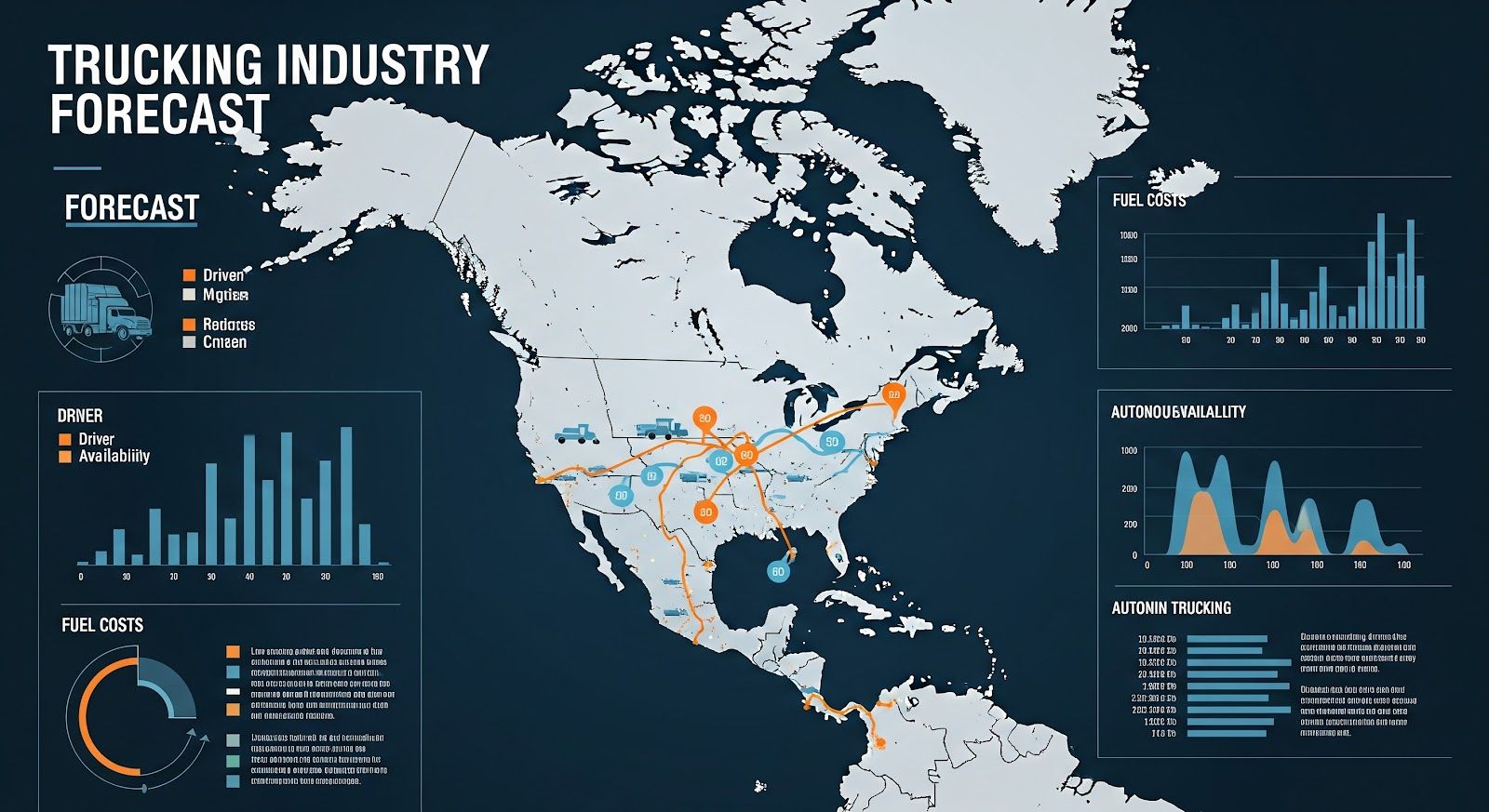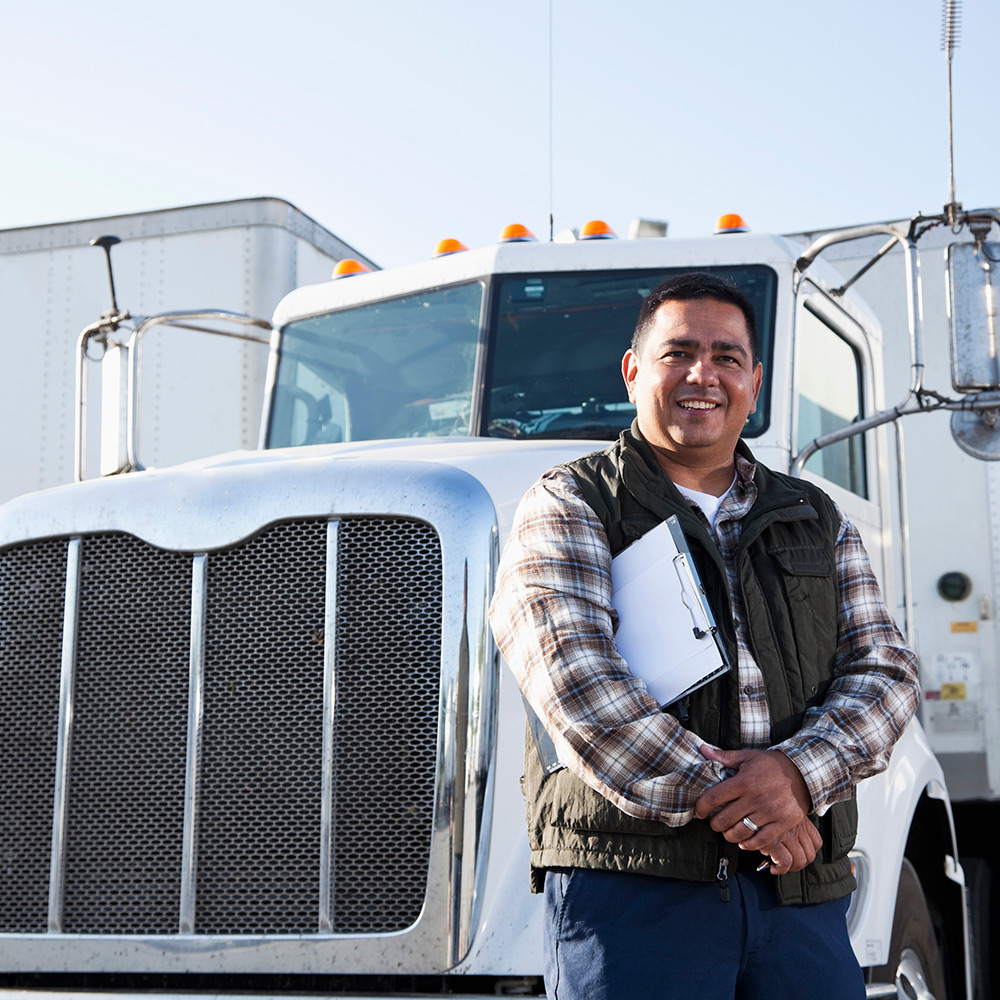Trucking Industry Forecast: What Fleets Need to Know for the Road Ahead

The U.S. trucking industry is the backbone of the national supply chain, responsible for moving over 70% of all freight by weight. From transporting raw materials to delivering finished goods to store shelves, trucks keep commerce flowing across thousands of miles of highway infrastructure every day. Whether it's food, fuel, medical supplies, or construction materials, nearly every sector of the economy relies on trucking in some form.
With over 3.5 million professional drivers and more than 500,000 for-hire carriers, the industry not only supports commerce but also provides millions of jobs and contributes significantly to GDP. In 2024 alone, the trucking sector generated an estimated $940 billion in revenue, underscoring its massive economic influence.
However, despite its scale and importance, the industry faces ongoing challenges—from fluctuating fuel prices and rising toll costs to labor shortages and regulatory changes. In this dynamic environment, fleet operators must stay ahead of the curve to remain competitive, compliant, and cost-efficient.
This trucking industry forecast aims to provide fleet managers, owner-operators, and logistics professionals with a forward-looking perspective on what lies ahead. From technology adoption and labor dynamics to infrastructure upgrades and tolling developments, we’ll explore the trends and insights that matter most—and how solutions like Bestpass can help fleets adapt and thrive in 2025 and beyond.
Economic and Regulatory Outlook
Understanding the broader economic and regulatory landscape is essential for fleets looking to navigate upcoming challenges and opportunities. Shifts in freight demand, inflation, and government policy will all play critical roles in shaping operational costs, routing strategies, and long-term investments.
A. Freight Demand and Economic Indicators
1. Impact of Inflation, Interest Rates, and GDP Growth on Freight Volumes
Freight demand in the U.S. is closely tied to economic activity. As the nation continues to recover from pandemic-era disruptions, inflation and interest rates remain volatile. High interest rates, implemented to curb inflation, have tempered consumer spending and slowed industrial output—both of which directly impact freight volumes.
For fleets, this means a more cautious environment where cost efficiency becomes a competitive advantage. A slower GDP growth rate in early 2025 suggests continued pressure on spot rates and capacity. However, sectors like healthcare, e-commerce, and energy remain resilient, offering targeted opportunities for specialized carriers.
2. Domestic vs. Cross-Border Shipping Trends
While domestic shipping still dominates, there’s a growing emphasis on cross-border logistics, particularly with Mexico and Canada under the USMCA agreement. Mexico, in particular, continues to emerge as a key manufacturing partner, driving demand for long-haul routes to and from southern border states like Texas and Arizona.
Fleets that operate internationally must also consider customs regulations, security protocols, and toll differences across borders. Strategic toll management—through services like Bestpass—can help optimize international operations by reducing delays and administrative overhead.
B. Regulatory Changes to Watch
1. FMCSA Rules, ELD Updates, and Emissions Regulations
The Federal Motor Carrier Safety Administration (FMCSA) continues to revise and enforce safety and compliance rules. New ELD (Electronic Logging Device) guidelines, anticipated by late 2025, may tighten exemptions and enhance enforcement mechanisms. Fleets must stay updated to avoid penalties and ensure driver compliance.
Additionally, the push for sustainability is bringing stricter emissions regulations. California’s Advanced Clean Fleets rule, for instance, requires many fleets to transition to zero-emission vehicles (ZEVs) over the next decade. These state-level mandates could soon be mirrored federally, requiring proactive investment in vehicle technology and charging infrastructure.
2. State-Specific Legislation That Could Impact Tolling and Routing
Several states are introducing or expanding congestion pricing and tolling programs—especially in high-traffic areas like New York City, Los Angeles, and parts of Texas. These changes can significantly affect fleet budgets and routing strategies. For example:
- New York’s congestion tolling plan may introduce per-vehicle charges during peak hours.
- Texas is reviewing new public-private tolling partnerships to expand highway infrastructure.
- Florida and Pennsylvania continue to adjust toll rates annually, increasing the importance of proactive toll budgeting.
Fleet operators must stay informed of these state-by-state developments and adjust routes accordingly. Partnering with toll management providers like Bestpass enables fleets to navigate complex toll networks with consolidated billing, real-time alerts, and cost-saving analytics.
Technology Trends Transforming Fleets
The trucking industry is in the midst of a technological revolution that is redefining how fleets operate, maintain efficiency, and stay competitive. From real-time data visibility to electric and autonomous vehicles, innovations are rapidly moving from experimental to essential. Fleets that embrace these tools stand to gain a significant edge in cost savings, compliance, and customer satisfaction.
A. Fleet Telematics and Data-Driven Management
Telematics systems have evolved beyond basic GPS tracking. Today’s solutions offer a comprehensive view of fleet operations, integrating data across tolling, fuel usage, driver behavior, vehicle health, and more.
- Real-time Toll Tracking: Platforms like Bestpass give fleets instant visibility into toll charges, helping to monitor daily spend, detect errors, and avoid violations before they escalate.
- Route Optimization: Advanced telematics use traffic data, weather patterns, toll costs, and delivery schedules to generate the most efficient routes—reducing idle time, fuel consumption, and wear-and-tear.
- Predictive Maintenance: By analyzing sensor data, telematics systems can alert fleet managers to potential mechanical issues before they result in breakdowns, helping prevent unplanned downtime and costly repairs.
With integrated dashboards and API capabilities, fleets can make data-driven decisions that improve efficiency and lower operational risk.
B. Electrification and Alternative Fuels
The transition to cleaner energy sources is gaining momentum in the trucking sector, driven by regulatory mandates, sustainability goals, and rising fuel costs.
- Growing Adoption of EVs and Hydrogen-Powered Trucks: Major manufacturers like Tesla, Volvo, and Nikola are investing heavily in electric and hydrogen vehicle platforms. Medium-duty and last-mile delivery fleets are leading the way in EV adoption due to shorter routes and easier access to charging infrastructure.
- Incentives and Infrastructure Availability: Federal and state programs are accelerating adoption by offering tax credits, grants, and rebates for electric trucks and charging stations. For instance, the Inflation Reduction Act provides up to $40,000 in federal tax credits for qualifying commercial EVs. Meanwhile, charging networks are expanding at truck stops and distribution centers across major corridors.
However, barriers remain—including high upfront costs and limited range for heavy-duty applications—so many fleets are adopting a hybrid approach with both traditional and alternative fuel vehicles.
C. Autonomous and Semi-Autonomous Vehicles
The long-term potential of autonomous trucking continues to attract attention from both investors and logistics providers. While fully driverless trucks are not yet road-ready at scale, semi-autonomous technologies are already making their way into commercial fleets.
- Timeline: Experts anticipate widespread semi-autonomous deployment (e.g., driver assist systems for highway driving) within the next 5–7 years. Full autonomy may follow in specific use cases such as terminal-to-terminal or platooning operations in the late 2020s.
- Impact on Logistics and Labor: Automation has the potential to reduce driver fatigue, increase safety, and extend operational hours. However, it also raises questions around workforce displacement, insurance liability, and regulatory frameworks. For now, most systems are being used to augment drivers, not replace them—offering safety enhancements like lane assist, adaptive cruise control, and automatic braking.
Forward-thinking fleets are beginning to test pilot programs, partner with technology providers, and invest in the infrastructure needed to support this evolution—ensuring they’re not left behind as the industry changes.
Tolling and Infrastructure Developments
As the U.S. continues to modernize its transportation network, tolling policies and infrastructure investments are reshaping how fleets move freight. For commercial carriers, these changes represent both challenges and opportunities—especially when it comes to cost management, route planning, and compliance. A strong tolling strategy, supported by intelligent tools like Bestpass, is becoming a competitive necessity.
A. Nationwide Tolling Expansion
Across the country, states are expanding tolling systems to generate revenue for infrastructure upkeep, reduce congestion, and fund new road projects.
- New Toll Roads & Managed Lanes: States such as Texas, Florida, and Georgia continue to build or expand toll roads and high-occupancy toll (HOT) lanes to relieve congestion. These corridors are increasingly used by commercial vehicles for faster, more predictable delivery times—at a cost that must be managed closely.
- Congestion Pricing Zones: Urban areas like New York City are launching congestion pricing programs, charging commercial vehicles premium rates during peak travel hours. This can significantly impact operating costs, especially for fleets that rely on daily access to city centers.
- Regional Policy Shifts: More states are considering mileage-based user fees and variable toll pricing based on vehicle weight or emissions. These shifts may further complicate toll budgeting and increase the importance of adaptive route planning.
In this evolving environment, having visibility into where and how toll costs are incurred becomes essential for fleet managers.
B. Importance of Toll Management Systems
As toll networks expand and grow more complex, manual toll tracking is no longer practical—or cost-effective.
- Automated Tracking & Billing: Toll management systems like Bestpass consolidate all toll transactions from across the country into a single, unified statement, eliminating the need to manage multiple accounts or paper invoices.
- Cost Reduction: By analyzing toll usage patterns, Bestpass helps fleets avoid unnecessary charges, identify better routes, and reduce costly violations. Some fleets report savings of 7–10% or more simply by optimizing toll usage and catching billing errors.
- Administrative Efficiency: Automated transponder management, license plate updates, and real-time toll insights reduce back-office workload and improve cash flow planning. This is particularly valuable for large fleets operating across multiple states and tolling authorities.
Bestpass also serves as a bridge between fleets and tolling authorities—ensuring timely, accurate payments and minimizing misreads or discrepancies.
C. Federal and State Infrastructure Spending
Massive government investment through legislation like the Bipartisan Infrastructure Law (BIL) is beginning to impact the nation’s transportation landscape.
- Highway and Bridge Upgrades: Billions are being allocated to repair aging bridges, repave highways, and expand freight corridors. While these projects promise long-term improvements, they can also create short-term detours, delays, and toll rerouting—requiring fleets to stay nimble.
- Smart Infrastructure and Digitization: Investments in smart traffic systems, weigh-in-motion stations, and vehicle-to-infrastructure (V2I) technology will further influence how trucks interact with toll networks and road systems. Fleets that embrace digital solutions will be better positioned to adapt.
- Fee Adjustments and Road Funding Models: As gas tax revenues decline, states are experimenting with new road funding models—such as vehicle-miles-traveled (VMT) fees and expanded tolling—to cover infrastructure costs. This shift could result in broader application of tolls across previously untolled roads.
Ultimately, infrastructure funding presents an opportunity for fleets to benefit from safer, faster, and more reliable routes—but only if they are prepared to manage the associated toll and compliance requirements effectively.
As U.S. trucking continues to evolve amid economic shifts, regulatory changes, and digital transformation, managing toll expenses and administrative tasks grows increasingly complex. Bestpass provides fleets nationwide with a streamlined toll management solution, consolidating transactions from over 50 tolling authorities into a single, user-friendly account. With real-time analytics, intuitive route optimization, simplified violation handling, and seamless integration with leading fleet technology partners, Bestpass helps keep your fleet compliant, efficient, and adaptable in a rapidly changing marketplace.

